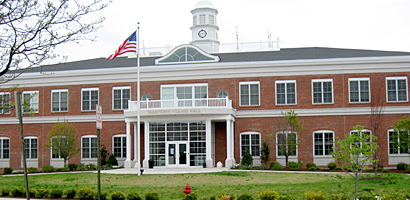 On March 24, 2010, Grassroots Environmental Education, in partnership with Pace University, announced the results of their How Green Is My Town? program, a county-wide, 142-point evaluation on how the towns and villages of Westchester County have addressed key environmental issues.
On March 24, 2010, Grassroots Environmental Education, in partnership with Pace University, announced the results of their How Green Is My Town? program, a county-wide, 142-point evaluation on how the towns and villages of Westchester County have addressed key environmental issues.
Each of the 43 participating municipalities ended up with a final score drawn from combining their scores in three areas: local government, the school district, and the local business community.
Our three villages fared from middle-of-the-road to poor, with Tarrytown coming in 19th out of 43, Sleepy Hollow 23rd, and Irvington 28th. The final scores are available to the public online at http://www.howgreenismytown.org/westchester/index.html, where you can find detailed reports on how the individual villages were scored, where they did well, and where improvements could be made. We contacted the Village Administrators — two of whom had been interviewed by the project back in January (in Irvington, the project interviewed Mayor Siegel instead of Administrator Giaccio) — to ask them how they felt about the project, their Village’s score, and what, if any, green initiatives were in the works.
Tarrytown
Tarrytown fared the best out of the three villages, coming in 19th out of 43. It scored high marks for its recycling policies, as well as for green efforts in transportation, including the new bike racks and bike paths, as well the purchase of two electric cars, and the upcoming purchase of a hybrid Senior Citizen van.
Moving forward, Village Administrator Michael Blau points to two upcoming projects — each funded by a grant from NYSERDA — that will hopefully begin within the next month. The first will be a solar panel array to be installed on the roof of the Village Hall, and the second is the replacement of all Village traffic lights with LED lights, which are more energy efficient as well as brighter than the lights currently in use.
Blau also touted an upcoming comprehensive energy audit that will be done on all Village-owned buildings sometime in May. “That will give us guidance as to what we need to do to make all of our buildings more energy efficient,” he explains. Even before then, the How Green Is My Town? survey has presented the Village with a number of ideas. “There are some simple fixes now, as I go through the How Green Is My Town? [survey], that I can get implemented fairly quickly,” he says. Some possible actions include ensuring that all Village buildings are using CFL bulbs, taking a look at Village building codes, and putting together a green purchasing policy.
One of the more far-reaching ideas being considered is having the Village offer Property Assessed Clean Energy (PACE) bonds. A PACE bond allows a municipality to lend funds to residential or commercial property owners to fund energy efficiency measures.
The loans are then repaid through an annual assessment on the owner’s property tax bill, with the amount of money saved by the energy efficiency retrofits generally greater each year than the annual cost. The PACE bonds began in California in 2008, and have quickly spread across the country, including the town of Bedford, here in Westchester. Says Blau, “We’re going to look at how financially feasible that program is.”
Sleepy Hollow
Sleepy Hollow’s final ranking in the survey — 23rd out of 43 — was not that surprising to Village Administrator Anthony Giaccio. “It’s nice to know we’re at least not at the low end of the survey.”
Two areas where Sleepy Hollow scored well were in recycling and sustainable building development. Giaccio acknowledged that Village policy towards new construction is definitely green-oriented, but, he admits, “Older construction, things like energy saving and improvements to our buildings in general — I think we still need some work.” An area in which Giaccio feels Sleepy Hollow deserves a lot of credit is in storm water management. “We’ve had a good policy in place for several years,” he says, pointing to the Village’s policy of replanting trees. “I think we plant 100 trees a year.” (These trees help reduce soil erosion and run-off caused by rain.)
Giaccio sees a greener future for Sleepy Hollow, in part thanks to the efforts of the current Board of Trustees. “This Board has demonstrated that [environmental issues are] a high priority,” he says. For example, the Board recently resurrected the Environmental Advisory Committee, and has plans to turn to hybrid or electric vehicles. “We’re hoping that within a year or two we’ll have at least one or two vehicles in our fleet that are hybrids,” says Giaccio.
Perhaps the most intriguing green project on the horizon for the town is the use of solar power. “The State is looking for locations for solar energy,” says Giaccio. “They need a fairly large area. We explored whether or not Sleepy Hollow has any possibilities.” One such possibility would be if the GM site were to be developed. The Village has considered purchasing property within the site and constructing a Village building (a fire station or Village Hall, for example) and incorporating solar energy on the roof. “It would lower our energy rates for many years to come,” says Giaccio.
Irvington
Irvington came in 28th out of the 43 communities surveyed. However, Village Administrator Lawrence Schopfer feels the results don’t tell the full story. “From our standpoint, we see Irvington as being rather progressive [on environmental issues.]” “There were a number of areas where the survey was looking for formal written policies,” he explains that while the Village takes environmental issues into account in many of its decisions, “We just don’t have the written procedures in place.” Still, having the results in hand has proven valuable. “We’ll use it as a guide,” he says. “The checklist is very helpful.”
Over the last couple of years, Irvington put together a Climate Protection Task Force, which did a sustainability survey in the Village and came back with a large number of suggestions. Says Schopfer, “We broke those suggestions down into those that were easily accomplished and easily funded — or maybe that didn’t even require funding — and those that were more difficult to implement or those that required considerable funding.”
Lack of funding has been a major obstacle in the Village’s green endeavors. They had a comprehensive energy audit completed and were preparing a series of energy efficiency efforts on Village buildings, that would go a long way towards reducing energy consumption and costs, when the economy tanked, and the projects were cancelled for the time being. They then tried to obtain Federal Stimulus funds to move forward with the project, but were rejected in three separate rounds of funding. Still, Schopfer holds out hope. “[Some] of the projects that we want to implement are these energy-saving measures, whether we get funded elsewhere or not.” The total costs for the measures are in the range of $200,000, and the items targeted are all low-hanging fruit that could conceivably pay back the cost in energy savings in six to eight years.
Though not at the top of the survey, Irvington takes great pride in their recycling efforts. In fact, they were recently recognized by the County and were given an award at the County’s Earth Day celebration. “We just found out that we were either second or third in the County in the recycling rate,” says Schopfer. “62% of the waste going through our waste stream is recycled.”
Looking into the future, one area Schopfer wishes to improve upon is public involvement, so everyone can take ownership of the issue (and the improvements) themselves. “I think that we would like to spend more time educating and teaching our residents how to recycle more or compost, for example,” says Schopfer, explaining that the more waste residents are able to keep on their property, through reduced consumption or composting, the less the Village has to spend in collecting and disposing it. “In the long run, of course, we’re doing it for the good of the environment, but we’re also doing it for the good of our budget.”






